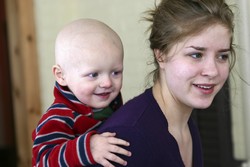Viruses to treat childhood brain tumours
Childhood brain tumours known as high-grade gliomas (HGGs) pose a great challenge to paediatric oncology with just 10 % survival. The current therapeutic choices are limited and cause severe neurologic and cognitive side-effects. Engineered oncolytic adenoviruses have emerged as an alternative approach to selectively target and destroy tumour cells. This selectivity is associated with specific cancer mutations in the p53 or the retinoblastoma (RB) tumour-suppressor genes. The goal of the EU-funded PEDIAVIR (New therapeutics strategies for the treatment of pediatric brain tumors) project was to evaluate the efficacy of the E1A mutant Delta-24-RGD oncolytic adenovirus in treating childhood brain tumours. Following infection, adenoviruses immediately express a viral protein called E1A, which binds to and inactivates cellular proteins such as the RB protein that controls the cell cycle. Engineered viruses with mutations in the E1A protein are unable to replicate in normal cells that have functional RB proteins, but they replicate and lyse cancer cells with inactivated RB. The first major project achievement was generation of paediatric glioma cell lines including HGGs. In parallel, researchers developed two mouse models of gliomas. These tools were crucial for the project and in general important for in-depth studies of the biology of these tumours as well as different therapeutic agents. Experiments with mutant Delta-24-RGD oncolytic adenovirus in generated cell lines showed that the virus was able to infect, replicate and kill glioma cells in vitro. Researchers also demonstrated a potent antitumour effect in vivo in the mouse models. Combination of the virus with different chemotherapeutics increased the efficiency of the treatment. These data validated application of the virus in combination with the drugs that are already used in the clinic. Importantly, this approach was extended to paediatric osteosarcoma, a common malignant bone tumour in children. Delta-24-RGD virus had a potent antitumour effect in osteosarcoma cell lines that was increased in combination with cisplatin chemotherapy. The results of the PEDIAVIR study are expected to form the basis for future clinical trials. The potential use of oncolytic adenoviruses constitutes a breakthrough in the treatment of this disease.







